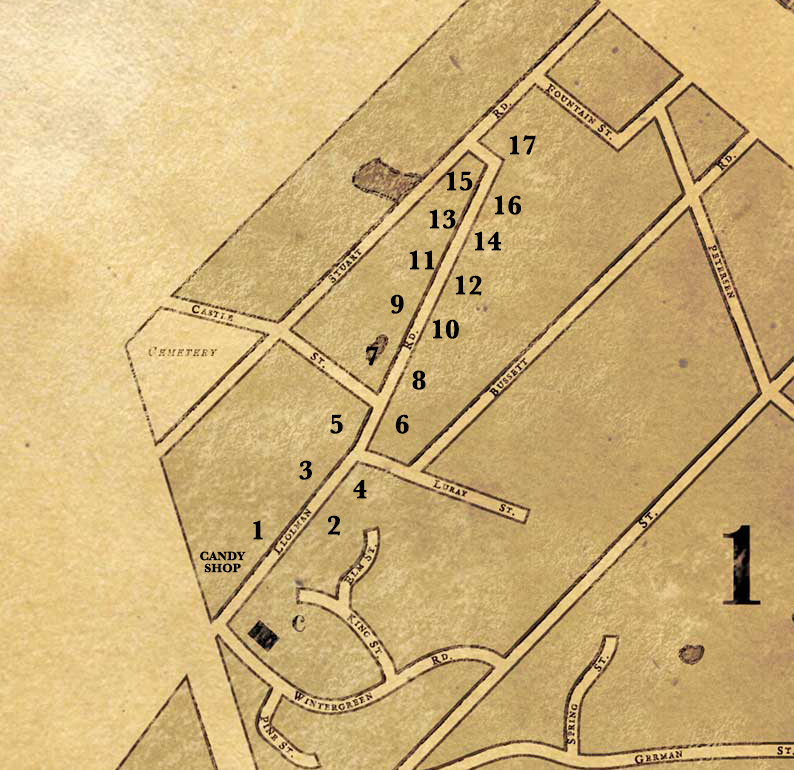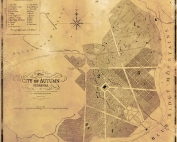Candy Lane
Candy Lane is the alternate street name for a series of seventeen colorful historic houses in Autumn, Virginia. Llolman Road, its official name, runs roughly southwest to northeast through the neighborhood of Northview.
***
The strip of cottages, villas, and town houses extend from Jefferson Road to Stuart Road The area is known for its lush tree coverage, picturesque views, and feeling of seclusion despite its close proximity to downtown.
Northview is one of the oldest neighborhoods in Autumn, made up of mostly Victorian houses that date from the 1880s when the city began its first economic boom. At the time, it was still on the outskirts of the city to the north, but the convenient location to both downtown and train access made it a haven for moderately upscale residents.
History
The first house built in 1880 was a for a friend of architect Harold Wick. It was a modest cottage with a simple color scheme. Soon after it was finished, a neighbor moved in across the street and constructed an ornate town house. Rumor has it that the owner of the cottage became angry because the new house blocked the sunrise. To compensate for the lack of warmth on his house, he decided to paint the cottage yellow.
The new resident, following a verbal argument, interpreted this to be a display of dominance and painted his home a new color that would attract as much attention. A rivalry began and expanded with each new resident, leading to a progression of more colorful and unique buildings.
Comprised of Victorian era architecture, visitors will find a mixture of Gothic, Romanesque, and classical elements on Candy Lane with rich colors—a stark contrast to the Jefferson style red brick and white trim architecture for which Autumn and most of Virginia are known. It has become a popular location for photographers.
One of the houses includes a tragic story. The last lot to be purchased was in 1901 near the east end of the street. The resident was a wealthy businessman who was charmed by the neighborhood and built a house on Llolman Rd. as a summer retreat. His son inherited the family fortune and house after the father passed away, but lost all of it after the stock market crash of 1929.
He was reported to have taken a train from New York to Autumn, walked home to his house on Llolman Rd. and hung himself in the upstairs stairwell, facing the stained glass window that looked east. The house has had trouble keeping tenants over the years and is currently vacant.
Name origin
The residential street takes its name both from the vibrant and varied exterior colors as well as a candy shop at the west end of the community. During the 1920s, at the corner of Jefferson Rd. and Llolman Rd., a candy shop moved into the tiny abandoned commercial building, providing soda and an assortment of treats for the neighborhood, specifically after church let out on Sundays across the street.
After the owner’s son died in World War II, the shop fell into decline. The owner sold the establishment to a patron who wanted to refurbish and expand the business. It is now a popular destination and symbolic starting point for visitors of Candy Lane.
Houses
Each of the Candy Lane houses are considered free-standing single-family detached homes. The following are historical backgrounds for the buildings.
1 East Lollman St.
2 East Lollman St.
3 East Lollman St. – The Jansen House
The two story gothic cottage sits near the corner of Llolman Rd. and Luray St. to the east of the first home. It dates to 1883 when Margaret Jansen and her husband, owners of a local flower shop, built the house with its signature St. Bernard statues at the base of the front steps.
4 East Lollman St.
5 East Lollman St.
6 East Lollman St.
7 East Lollman St.
8 East Lollman St.
9 East Lollman St.
10 East Lollman St.
11 East Lollman St.
12 East Lollman St.
13 East Lollman St.
14 East Lollman St.
15 East Lollman St.
16 East Lollman St.
17 East Lollman St.
Behind the Scenes
The buildings are modeled, textured, and rendered using Blender 3d. The final goal of the mini-project is to create a series of oil paintings connected to a unique backstory. The renders provide both reference for the painting process as well as mock historical photographs.
Come participate in the project and create a whole new story!
Share This Story, Choose Your Platform!
Candy Lane
Candy Lane is the alternate street name for a series of seventeen colorful historic houses in Autumn, Virginia. Llolman Road, its official name, runs roughly southwest to northeast through the neighborhood of Northview. [...]
Original 1879 City Plan of Autumn
Look what I discovered while rummaging through old stacks at the Autumn Historical Society. It's the original 1879 plan of the city! Also known as the Wick Plan, named for architect and engineer Harold Wick, this city grid [...]
Train Station – Early Digital Painting Sketch
This was an early test of combining a 3d model with a photograph for reference. Instead of working from photographs only, I wanted to test my digital painting skills and my 3d modeling. Original [...]






